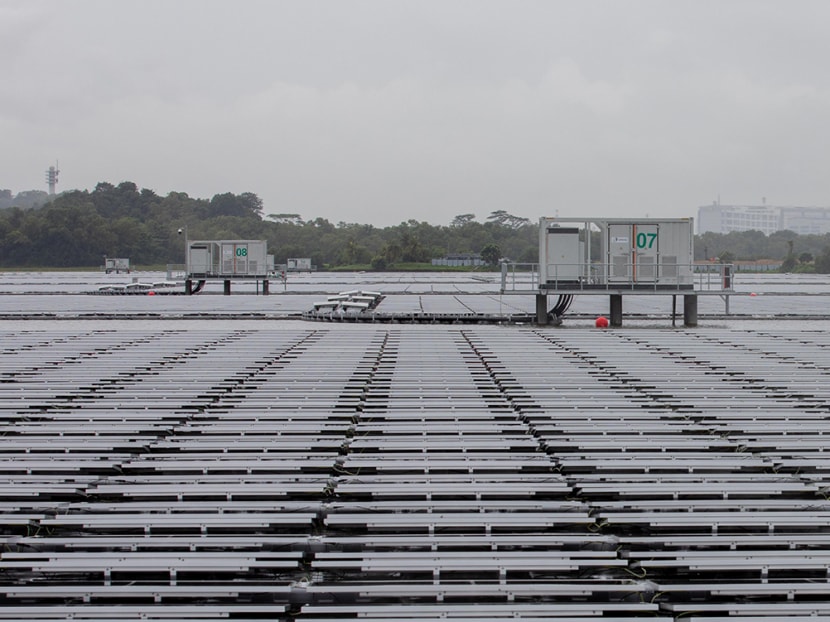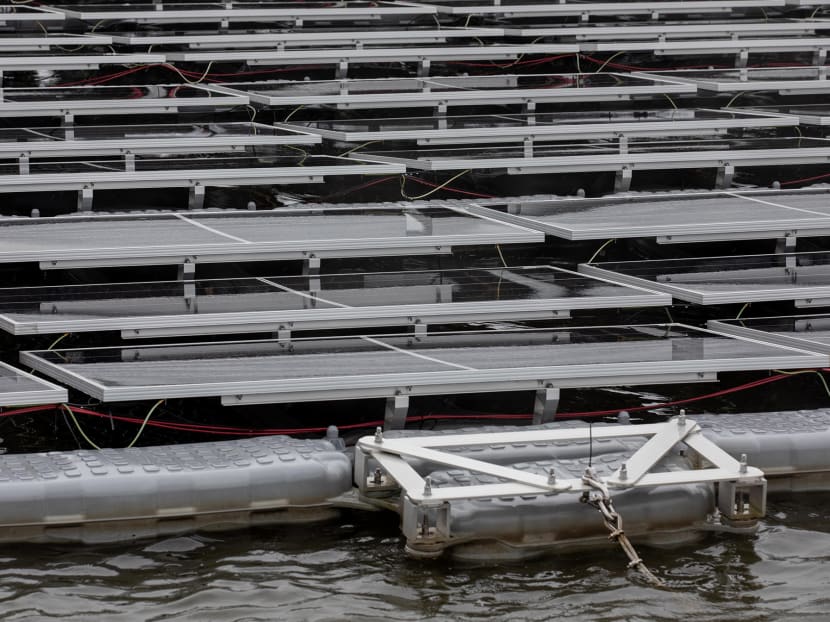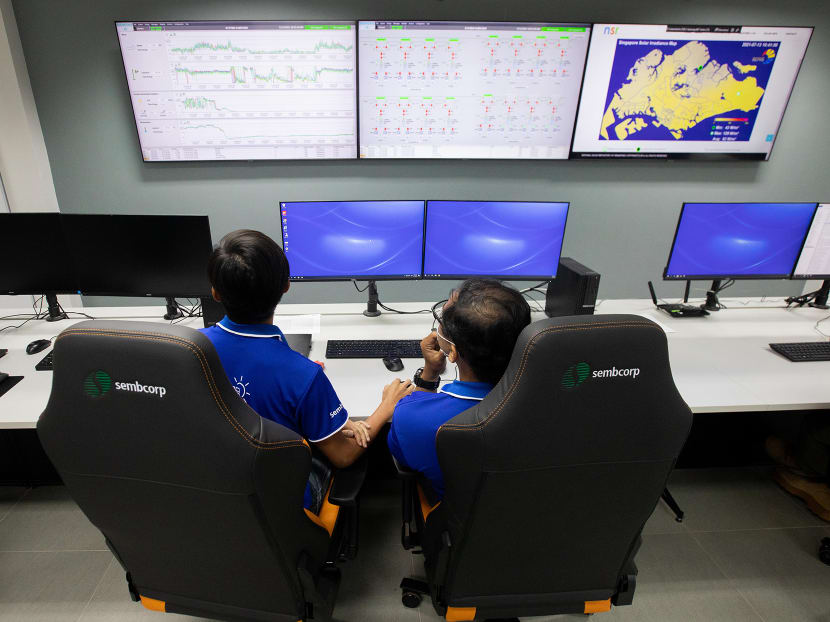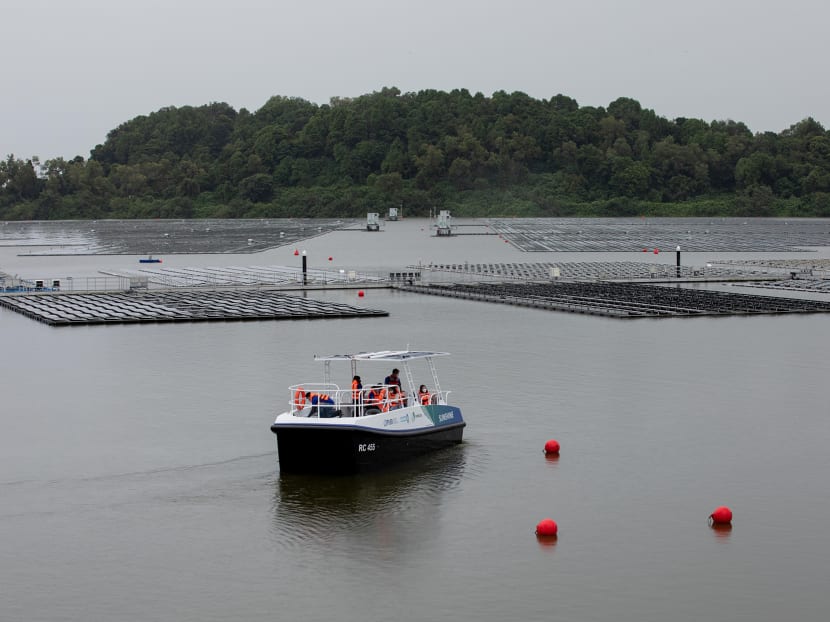Tengeh Reservoir floating solar farm opens with 122,000 panels that will power S'pore's 5 water treatment plants
SINGAPORE — Just before Tuas Checkpoint at the Singapore-Malaysia border, rows of black-and-silver solar panels line one-third of the waters in Tengeh Reservoir.
- The Sembcorp Tengeh Floating Solar Farm at Tengeh Reservoir was officially launched on July 14
- Spanning 45 hectares, it is Singapore’s largest solar farm
- The farm’s capacity is 60MWp and will offset the energy needs of all five of PUB’s water treatment plants
- PUB and Sembcorp have taken steps to ensure that wildlife and water quality of the reservoir are not affected by the solar panels
SINGAPORE — Just before Tuas Checkpoint at the Singapore-Malaysia border, rows of black-and-silver solar panels line one-third of the waters in Tengeh Reservoir.
Spanning about 45 hectares, or the size of 45 football fields, these 122,000 solar panels form Singapore’s largest floating solar farm to date.
The Sembcorp Tengeh Floating Solar Farm was officially launched by Prime Minister Lee Hsien Loong on Wednesday (July 14), a month after it began operations.
It is the latest of such farms to open in Singapore, following that of a floating testbed in the same reservoir in 2016 and the Sunseap Floating Solar Farm in the Strait of Johor in March this year.
Speaking at the launch at Tengeh Reservoir on Wednesday, Mr Lee said that while the Government has tried to capitalise on solar power by building solar panel systems on rooftops and vacant state properties, it still lacked large plots of land to scale up solar deployment.
“Hence, the idea of a floating solar farm was attractive, because it allowed us to make full use of the large surface area of reservoirs, while giving them a dual use.”
Mr Lee said that the testbed in Tengeh Reservoir performed up to 15 per cent better than conventional rooftop solar power systems due to the cooler environment at the reservoir.
.embed-container { position: relative; padding-bottom: 56.25%; height: 0; overflow: hidden; max-width: 100%; } .embed-container iframe, .embed-container object, .embed-container embed { position: absolute; top: 0; left: 0; width: 100%; height: 100%; }ENOUGH POWER FOR 16,000 HDB FLATS A YEAR
The country’s latest solar farm in Tengeh Reservoir is a 60 megawatt-peak (MWp) solar photovoltaic farm.
The amount generated is enough to power about 16,000 four-room Housing and Development Board (HDB) flats a year.
In terms of carbon savings, this translates to a reduction of 32 kilotonnes yearly, or the equivalent of taking 7,000 cars off the roads.
The energy generated by the farm will offset the energy needs of all of Singapore’s five water treatment plants, which make up 7 per cent of PUB’s annual energy needs.
In a joint press release on Tuesday, national water agency PUB and Sembcorp Floating Solar Singapore, a subsidiary of engineering firm Sembcorp Industries, said that the power generated by the solar farm will contribute to the national goal of quadrupling solar energy deployment to 1.5 gigawatt peak (GWp) by 2025.
The Tengeh solar farm will contribute around 4 per cent of Singapore’s target.

Mr Ng Joo Hee, chief executive of PUB, said: “With this floating solar power plant, which we believe to be one of the largest in the world, PUB takes a big step towards enduring energy sustainability in water treatment.
“Solar energy is plentiful, clean and green, and is key to reducing PUB’s and also Singapore’s carbon footprint.”
Mr Wong Kim Yin, chief executive officer of Sembcorp Industries, called the farm a “crown jewel” in its portfolio.
“It is a great example of how Singapore can harness renewable energy despite our limited land resources,” said Mr Wong at the launch event.
“As the leading homegrown renewable energy player, Sembcorp has over 3,300 megawatts of renewable energy assets around the world. We are committed, and have the track record and competencies, to support the Singapore Green Plan.”
The Singapore Green Plan is a whole-of-government effort to make Singapore become more sustainable and reach the nation’s target to peak its emissions to 65 million tonnes of carbon dioxide equivalent by 2030.
Sembcorp declined to disclose the cost of the project due to commercial sensitivities.

Completed within a year, the farm is made up of 10 floating solar panel “islands” of varying sizes, with each island containing an average of 15,000 panels.
Each 1m-by-2m panel, which has a lifespan of 25 years, can generate 490 watt peak.
Both sides of the solar panels are covered in glass to prevent moisture from getting trapped in them. This enhances the durability of the panels in Singapore’s wet and humid environment.
The panels are also bifacial, meaning that power can be produced from both sides, even the underside facing the water. It does so by absorbing the sun’s rays that are reflected from the water’s surface.
Two to four personnel oversee the farm’s operations daily, with another 30 deployed for operations and maintenance work.
Drones are also used for regular operations and maintenance checks, helping to shave off manual inspection costs by 30 per cent.
In its media release, PUB said that its main concern with deploying solar panels on reservoirs was the potential impact on the surrounding environment, biodiversity and water quality.
However, results from its testbed deployed at Tengeh Reservoir in 2016 showed no observable change in water quality. There was also no significant impact on the surrounding wildlife.

The agency also conducted a comprehensive environmental impact study including biodiversity surveys and water quality monitoring, and held consultations with nature groups between 2015 and 2018 to work on minimising any impact on wildlife due to the solar farm.
To improve the airflow and allow enough sunlight to reach flora and fauna in the water, there are gaps between the solar panels, for instance. Extra aerators are in place to maintain the oxygen levels in the reservoir.
Several other floating panel solar systems are in the works, with one in Lower Seletar Reservoir and another in Bedok Reservoir expected to be completed this year. Both systems will have a capacity of 1.5 MWp each.
Environmental studies are ongoing for two other floating panel solar systems in Kranji Reservoir and Upper Peirce Reservoir.
Petroleum giant Shell and government agency JTC Corporation also inked a non-binding memorandum of understanding last month to set up an offshore solar farm in Semakau Island. It is expected to be more than twice the size of the Tengeh Reservoir solar farm, allowing it to generate a capacity of 72 MWp.









